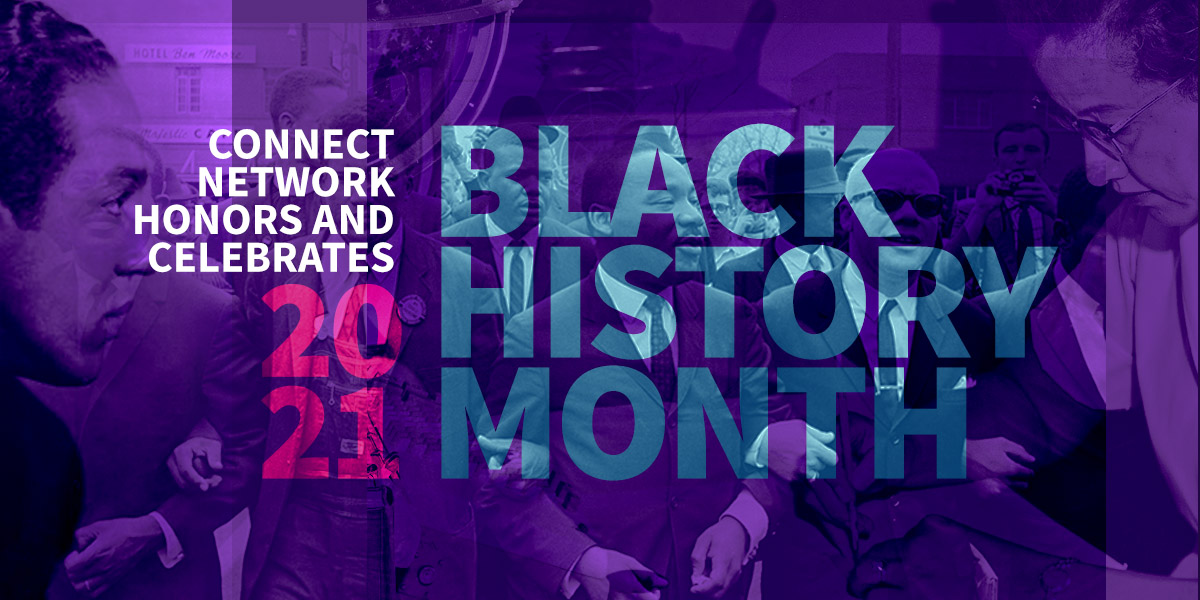GTL Celebrates Black History Month, Continues Mission of Diversity & Inclusion
février 12, 2021
In 2020, GTL held a series of internal meetings to engage team members and discuss issues affecting both the company and its customers. These meetings stressed the importance of an inclusive environment for all GTL employees, including issues related to diversity, inclusion, and belonging.
With February being Black History Month, GTL is taking the opportunity to highlight and celebrate diversity and inclusion within the company and its communities. Black History Month is a time to honor black Americans and their artistic, cultural, scientific, and political contributions.
Black History Month is about creating community and connection through education, not just among the African American community, but for anyone who seeks to expand their awareness and understanding.
There are many resources available for those wanting to educate themselves about black history and race and identity, including:
- Association for the Study of African American Life and History
- Schomburg Center’s Black Liberation Reading List for Adults
- “What I Hear When You Say” video series by PBS
During each week of February, GTL will highlight the historical contributions of a black American and how their achievements changed lives.

Thomas L. Jennings: First Black American Patent Holder
Thomas L. Jennings was the first black American to receive a patent (US Patent 3306x), which was awarded on March 3, 1821. Jennings’s patent generated controversy because slaves were not able to patent their own inventions during this time and would not be able to until 1861. However, Jennings was a free man and able to gain exclusive rights to his invention and profit from it.
What was his invention? It was a process called dry-scouring, which was the forerunner of today’s modern dry-cleaning. He owned and operated a tailoring business in New York City, where he heard customer complaints about the difficulty of removing stains and grime. His dry-scouring process allowed clothes to keep their original shape and have the appearance of being new.
Jennings was a passionate abolitionist and used the income from his invention to free members of his family from slavery, as well as fund abolitionist causes. He also served as assistant secretary of the First Annual Convention of the People of Color in June 1831.
Unfortunately, no one will ever know Jennings’s exact scouring method, as his patent is one of the 10,000 or so “X-patents” that were lost in a fire in 1836 and never recovered.
 Dr. Alexa Canady: First Black American Female Neurosurgeon
Dr. Alexa Canady: First Black American Female Neurosurgeon
Dr. Alexa Canady faced many obstacles in becoming the first black American female neurosurgeon, but she famously stated that “The greatest challenge I faced in becoming a neurosurgeon was believing it was possible.”
Originally graduating from the University of Michigan with a degree in zoology, it was during her undergraduate studies that she became interested in medicine for the first time. She received her M.D. with cum laude honors from the University of Michigan Medical School in 1975, was accepted as a surgical intern at Yale-New Haven Hospital the same year, and finished her residency in neurosurgery at the University of Minnesota in 1981.
Dr. Canady specialized in pediatric neurosurgery, taking care of young patients facing life-threatening illnesses, gunshot wounds, head trauma, hydrocephaly, and other brain injuries and diseases. She chose pediatrics because of her love of the children in the pediatric ward during her residency, stating “it never ceased to amaze me how happy the children were.” Dr. Canady also paved the way as the first Black Chief of Neurosurgery at Children’s Hospital of Michigan.
She was featured in a Nickelodeon Black History Month short animation that aired in February 2015 to celebrate her achievement of being the first Black American woman to become a neurosurgeon. Throughout her career, Dr. Canady helped thousands of patients, most of them age 10 or younger. While Dr. Canady first retired in 2001 and moved to Florida, she quickly began to practice part-time at Pensacola’s Sacred Heart Hospital after learning there were no pediatric neurosurgeons in the immediate area. She officially retired from practicing medicine in 2012 but continues to be an advocate for young women pursuing careers in medicine and neurosurgery.
 Madam C.J. Walker – First Female Black American Entrepreneur and Millionaire
Madam C.J. Walker – First Female Black American Entrepreneur and Millionaire
Madam C.J. Walker was an entrepreneur, philanthropist, and political and social activist, as well as the first black woman millionaire in America. Born Sarah Breedlove to Louisiana sharecroppers, she was the first person in her family to be born free after the Emancipation Proclamation and made her fortune from a homemade line of hair care products for black women.
After a hair disorder caused her to lose much of her own hair, Walker created the “Walker system” and completely changed the black hair care industry. During the height of her career from 1911 to 1919, Walker and her company, Madam C.J. Walker Manufacturing Company, employed several thousand women as sales agents who visited houses across the United States and in the Caribbean, offering Walker’s hair pomade and other products.
A fierce entrepreneur, Walker was also deeply philanthropical. She encouraged employees to give back to their communities. During a time in which jobs for black women were limited, she promoted female talent and stipulated in her company’s charter that only a woman could serve as president. In addition to sales training, Walker showed other women how to budget, build their own businesses, and become financially independent.
Madam C.J. Walker was a pioneering black female entrepreneur who inspired and helped thousands during and after her lifetime. She donated to educational causes and black charities, including funding scholarships for women at Tuskegee Institute and donating to the NAACP, the black YMCA, and dozens of other organizations.
 Carlton A. Funn, Sr. – Historian and Creator of National/International Cultural Exhibits (NICE)
Carlton A. Funn, Sr. – Historian and Creator of National/International Cultural Exhibits (NICE)
Carlton A. Funn, Sr. was a historian and history teacher, as well as father to Marc Funn, GTL Marketing Specialist. Born in Alexandria, VA in 1932, Mr. Funn graduated in 1953 from Storer College in Harper’s Ferry, WV, with a B.A. in Education and obtained a Master’s in Education from Virginia State University in 1972. As a 7th grade student at segregated Lyles-Crouch School, he studied from the history book, Virginia: History, Government, Geography. In 1955, after having served in the U.S. Army, he returned to teach history at Lyles-Crouch, where he began to collect memorabilia, artifacts, artwork, pamphlets, and other information to educate his students on the many contributions and achievements of African-Americans throughout our country’s history. Over the years the collection grew in size and scope, and in 1969, he displayed the exhibit, then called the Afro-American Experience, for the first time. During the 1970s, he realized our community and country were becoming more culturally diverse and always the visionary, he expanded the exhibit to include sections on Latino-Americans, Asian-Americans, Native-Americans, among many other cultures, thus changing the name to The History and Culture of Minorities and finally National/International Cultural Exhibits (NICE).
As the exhibit traveled the country, Mr. Funn once again sought to add more diversity and created special sections on Martin Luther King, Jr. and the Civil Rights Movement, and the status of Women, the elderly, and the handicapped. A subset of places the exhibit has been displayed over the years includes: the Alexandria Police Department, Xerox Corporation, Dept. of Energy, Dept. of Labor, Smithsonian Folklife Festival, the Pentagon, George Washington University, Ft. Belvoir, VA, Ft. Meade, MD, Bolling AFB, and Terre Haute, IN, Federal Penitentiary. Over an incredible 52-year period, the exhibit was presented more than 550 times in 13 states. The entire exhibit would fill a gymnasium. Mr. Funn retired in 2000 after 38 years in the classroom.
He received numerous awards and honors during his career, including the National Council of Negro Women Mid-Atlantic Teacher of the Year; 2007 Alexandria Living Legend Award; and induction into the Alexandria African-American Hall of Fame. Dr. Carter G. Woodson, the founder of Negro History Week, later Black History Month, was the inspiration for his efforts to educate, and in 1978, Mr. Funn received the Carter G. Woodson Award from the National Education Association. He was a founding member and past President of the Alexandria Society for the Preservation of Black Heritage and the creator of the annual Martin Luther King Poster Exhibition for Alexandria Public School students, now in its 31st year. He has received resolutions and recognition for his achievements from the U.S House of Representatives, the Virginia General Assembly, and the City of Alexandria. Mr. Funn passed away in 2012, leaving a long and lasting legacy.
 Pedro Sierra – Negro National League Baseball Player
Pedro Sierra – Negro National League Baseball Player
When Jackie Robinson broke the Major League Baseball color barrier in 1947, Pedro Sierra knew his dream was going to become a reality. Father of three sons, including Pete Sierra, GTL Site Administrator, Pedro Sierra grew up in Cuba and began a storied 22-year baseball career starting in 1954.
Like almost every other kid in Havana, Pedro Sierra was 5 or 6 when he first started to play baseball and dream of a career in the big leagues. Growing up in a one-room tenement, Mr. Sierra used baseball to lift him out of his situation. In 1954, baseball scout Maximo Sanchez signed him to a $100-a-month contract with the Indianapolis Clowns after being impressed by his fastball, which he was said to throw at speeds over 90 miles per hour. In the U.S., Pedro Sierra was 16 years old and playing games once or twice a day from April through August at locations ranging from stadiums to cow pastures.
After spending the 1954–55 season with the Clowns, Mr. Sierra moved on to the Detroit Stars in 1956. However, the Vietnam War derailed his major league hopes, and he spent two years pitching for the Army’s Fort Hood Tanks. After returning to baseball in 1961, he spent time with the Minnesota Twins, Washington Senators, Texas Rangers. In what is believed to be one of the last instances of a Negro League player signing a major league contract, Mr. Sierra signed with the Washington Senators in (1969)as a batting practice pitcher for their last home game at RFK Stadium. Pedro also played in the Canadian Provincial League, and Mexican League before retiring after 22 years as a professional player.
After retiring from baseball, Mr. Sierra settled in Maryland. There he created a sports program for at-risk youth and ran it for 25 years. Now settled near Atlantic City, New Jersey, Mr. Sierra is one of approximately 150 Negro League ballplayers alive today.
Reach out to your loved one and extend your support!
Posted In: Blog



